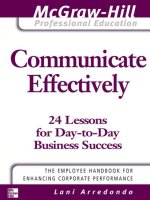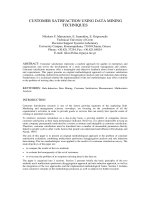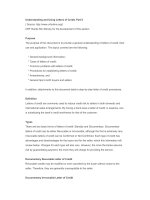Using transitions effectively
Bạn đang xem bản rút gọn của tài liệu. Xem và tải ngay bản đầy đủ của tài liệu tại đây (269.22 KB, 4 trang )
Page 1 of 4
Using Transitions Effectively
What do Transitions Do?
Transitional words and phrases are also called signal words. They are placed at key points
to lead the reader through the sentences and paragraphs. Using transitional words will help
you achieve clear and coherent communication with your audience.
When writers connect sentences and paragraphs, they provide a sense of movement that
allows their readers to follow the main and subordinate ideas easily and, as a result,
understand the writer’s purpose and message.
Clear transitions are essential to the coherence of paragraphs and essays. There are several
types of transitions, each leading the reader to make certain connections or assumptions
about the areas you are connecting, based on the words or phrases you choose. Some lead
the reader forward and imply the "building" of an idea or thought, while others make the
reader compare ideas or draw conclusions from the preceding thoughts. A list of common
transitional words and phrases can be found on the back.
Transitions Between Paragraphs
When linking two paragraphs, the writer must explain how the two paragraphs are
connected logically. Transitional words or phrases sometimes will be precisely what you
need to underscore for your readers the intellectual relationship between paragraphs—to
help them navigate your essay. Very often, such transitions:
Address an essential similarity or dissimilarity (likewise, in contrast, despite, etc)
Suggest a meaningful ordering, often temporal (first, in addition) or causal (thus,
therefore)
In a longer paper, remind the reader of what has earlier been argued (in short, as has
been said, on the whole).
Tips for Transitioning
Since clarity and effectiveness of your transitions will depend greatly on how well you have
organized your paper, you may want to evaluate your paper’s organization before you work
on transitions. In the margins of your draft, summarize in a word or two what each
paragraph is about or how it fits into your analysis as a whole. This exercise should help you
to see the order and connection between your ideas more clearly.
If after doing this exercise you find that you still have difficulty linking your ideas together
in a coherent fashion, you problem may not be with transitions but with organization.
Perhaps something crucial is missing between this paragraph and it neighbors—most likely
an idea o a piece of evidence or both. Maybe the paragraph is misplaced, and logically
belongs elsewhere.
Common transitional words and phrases can be found on the next page…
Courtesy the Odegaard Writing & Research Center
/>Adapted from UW Expository Writing Program and Edmonds Community College Writing Center handouts
Page 2 of 4
COMMON TRANSITIONAL WORDS & PHRASES
To Indicate
TIME ORDER
To Indicate
CONTRAST
To Indicate
COMPARISON
To Indicate
CAUSE & EFFECT
earlier
former
formerly
heretofore
in retrospect
in the past
not long ago
of late
preceding
previously
prior to
recently
yesterday
---------------------- at present
at the same time
at this moment
by now
concurrently
currently
immediately
now
presently
right away
simultaneously
until now
---------------------- henceforth
hereafter
in the future
---------------------- after a long time
after a short
while
afterward
later on
not long after
right after
soon after
thereafter
a clear difference
a distinct
difference
a striking
distance
a strong
distinction
against
although
although this
may be true
an opposing view
and yet
another
distinction
balanced against
but
by contrast
contrarily
contrary to
conversely
counter to
despite
despite the fact
that
different from
even though
for
however
in contrast
in opposition to
nevertheless
nonetheless
on the contrary
on the other
hand
opposing
otherwise
regardless
the antithesis of
the reverse of
to differ from
to differentiate
to oppose
up against
whereas
while
yet
after all
along the same
lines
also
analogous to
as compared with
as well as
balanced against
by comparison
comparable
comparatively
compared to
consistent with
conversely
correlate
correspondingly
equal
equally important
equivalent
however
identical
in a similar
fashion
in comparison
in contrast
in like manner
in the same
manner
in the same way
like
likewise
matching
meanwhile
nevertheless
of little difference
parallel to
relative to
relatively
resemble
resembling
similarly
synonymous
the next likeness
to the same
extent
too
uniformly
where
whereas
accordingly
as a consequence
as a result
as a result of
because
because of this
by reason of
caused by
consequently
due to
following that
for
for this purpose
for this reason
furthermore
hence
henceforth
in conclusion
in effect
in view of
it follows that
on account of
otherwise
owing to
so
subsequently
the end result
the outcome
the ramifications
of
then
thereafter
therefore
thus
to this end
accordingly
as a result
consequently
hence
it follows, then
since
so
then
therefore
thus
Courtesy the Odegaard Writing & Research Center
/>Adapted from UW Expository Writing Program and Edmonds Community College Writing Center handouts
Page 3 of 4
To Indicate
SEQUENCE
To Indicate
ADDITION
To Provide An
EXAMPLE
To EMPHASIZE or
INTENSIFY
at first
at the beginning
at the onset
commencing with
earlier
embark
first
from this point
in the first place
initially
once
once upon a time
starting with
to begin with
---------------------- after that
following that
immediately
following
in the second
place
in turn
later on
next
on the next
occasion
second /secondly
so far
subsequently
the following
week
the next day
the next time
the second stage
twice
---------------------- in the third place
last
last of all
third
at last
lastly
in the last place
the latter
at the end
in the end
final
finally
the final point
to conclude
in conclusion
after
afterward
again
also
and
and then
besides
concurrently
consequently
equally important
finally
following this
further
furthermore
hence
in addition
in fact
indeed
lastly
moreover
next
nor
now
previously
simultaneously
so too
subsequently
therefore
thus
too
what's more
a case in point
after all
an analogy
analogous to
another way
as an example
as an illustration
consider
consider as an
illustration
for example
for instance
for instance
for one thing
in another case
in fact
in one example
in order to clarify
in other words
in particular
in the following
manner
in the same
manner
in this case
in this situation
in this specific
instance
more exactly
namely
on this occasion
specifically
such as
suppose that
take the case of
that is
to be exact
to bring to light
to clarify
to demonstrate
to exemplify
to explain
to illuminate
to illustrate
to put another
way
to show
to take a case in
point
to take a case in
point
above all
actually
after all
as a matter of
fact
certainly
decidedly
definitely
equally important
especially
furthermore
in fact
increasingly
important
indeed
more
emphatically
more important
moreover
most important of
all
most of all
of great concern
of major concern
primarily
significantly
surely
the crux of the
matter
the main issue
the main problem
the major reason
there is no
question that
to be sure
to emphasize
to recapitulate
very likely
without a doubt
without doubt
without question
Courtesy the Odegaard Writing & Research Center
/>Adapted from UW Expository Writing Program and Edmonds Community College Writing Center handouts
Page 4 of 4
To Indicate
EXCEPTION
To SUMMARIZE or
CONCLUDE
To Connect
CLAUSES*
To Connect
CLAUSES cont.*
COORDINATION
CONJUNCTIONS
and
but
for
nor
or
so
yet
SUBORDINATING
CONJUNCTIONS
after
although
as
as if
as though
because
before
even
even if
even though
if
in order that
once
rather than
since
so that
than
that
though
unless
until
when
whenever
while
despite
however
in spite of
nevertheless
of course
once in a while
sometimes
still
yet
To ELABORORATE
actually
by extension
in short
in other words
to put it another
way
to put it bluntly
to put it
succinctly
ultimately
To CONCEDE
admittedly
although it is true
that
granted
I concede that
of course
naturally
to be sure
accordingly
as a result
as has been noted
as I have said
as I have shown
consequently
hence
in brief
in conclusion
on the whole
on the whole
summing up
therefore
thus
to conclude
as a result
consequently
hence
in conclusion,
then
in short
in sum, then
it follows, then
so
the upshot of all
this is that
therefore
thus
to sum up
to summarize
* NOTE:
Conjunctions do
more than simply
link and connect
ideas. Conjunctions
combine clauses
which transitional
words cannot do.
This is a significant
difference between
conjunctions and
transitional words
Courtesy the Odegaard Writing & Research Center
/>Adapted from UW Expository Writing Program and Edmonds Community College Writing Center handouts









